Related Story: Surfers pining for good old days build boards from scratch
Related Story: Meet the 12-year-old who started an eco-friendly surf wax business with $20
It’s surfing’s dirty little secret.
Key points:
- Surfboards are usually made from toxic, non-biodegradable petrochemical products
- Wooden surfboards are making a resurgence as a sustainable alternative
- “Green” surfboards need the support of professional surfers to become mainstream
The boards used to catch waves are made from toxic, non-biodegradable petrochemical products that belie the idyllic images of humans interacting with the forces of nature.
Surfboard construction has largely stayed the same since the late 1950s when the first foam and fibreglass boards emerged from Malibu in California.
Before that, they were built from timber. Veteran surfboard builder Tom Wegener now hopes to start a revolution by getting more surfers back onto wooden boards.
A sustainable way to surf
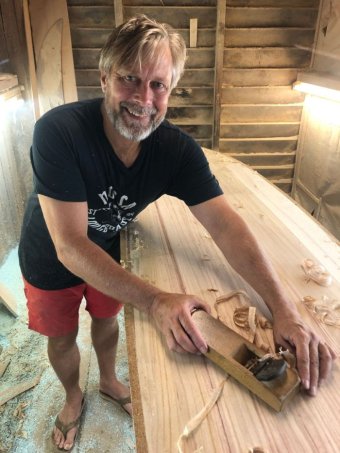 Photo: Mr Wegener uses fast-growing paulownia hardwood to create his surfboards. (ABC Landline: Sean Murphy)
Photo: Mr Wegener uses fast-growing paulownia hardwood to create his surfboards. (ABC Landline: Sean Murphy)“My goal is to make boards in my shed without fumes,” Mr Wegener said.
“My goal is to teach people, kids mostly, to make surfboards in their garage.”
Mr Wegener, 55, gave up a career in law in his native California to travel the world as a professional longboarder.
He arrived in Noosa in 1998 as part of a surf film promotion and loved the place so much he decided to stay.
After being introduced to paulownia timber by Australian surfboard manufacturer Paul Joske, he began a 15-year journey of discovery and innovation.
In 2009, he was named the best shaper in the world by the influential United States magazine Surfing, for starting a revival of ancient Hawaiian wooden surfboards, which he popularised using Australian-grown paulownia.
“It’s the best wood in the world for making surfboards,” he said.
“It doesn’t absorb salt water, it’s light, it carves really easily with your planers, it’s grown in plantations, it’s been around forever, it takes varnishes and oils, it paints really well, it’s just a very versatile plantation-grown timber.”
Mr Wegener completed a doctoral thesis at the University of the Sunshine Coast in 2013 on the sustainability of the surfing industry.
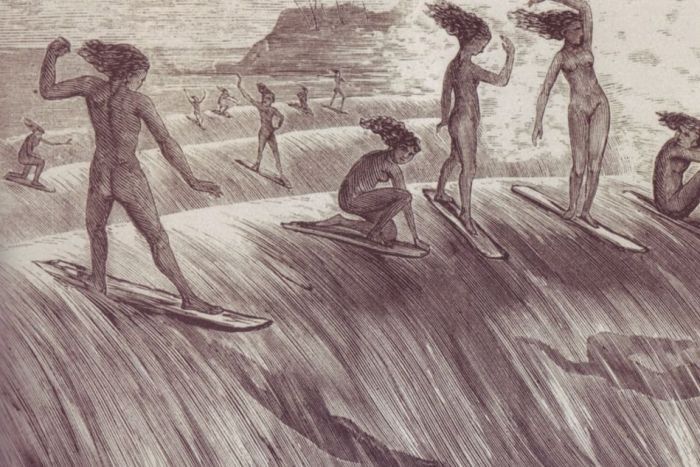 Photo: An etching by Wallis McKay, circa 1874, depicting local surfers in Hawaii using wooden boards. (Supplied )
Photo: An etching by Wallis McKay, circa 1874, depicting local surfers in Hawaii using wooden boards. (Supplied )He said about $4 billion worth of surfboards were produced each year globally, but the industry had made little progress in moving away from its reliance on petrochemicals.
Australia’s state-based workplace safety regulations have come a long way since the 1970s when the first serious health effects of working with polyurethane foam and polyester resins emerged.
Businesses such as The Glass Lab at Tweed Heads in New South Wales must now follow strict WorkSafe guidelines.
Manager Jason Frost said the company invested close to a million dollars two years ago in a new factory with a state-of-the-art extraction system for removing dust and dangerous fumes.
“If we remove everything out of the air, we are as good as any other factory for any industry anywhere in Australia,” he said.
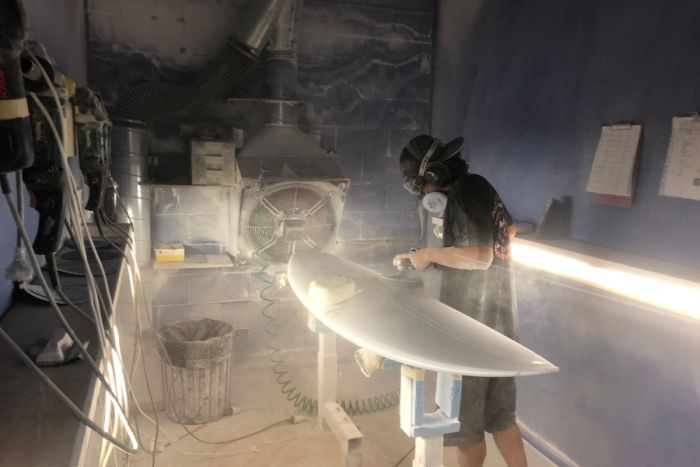 Photo: Dangerous fumes and toxic products are part of commercial surfboard construction. (ABC Landline: Sean Murphy)
Photo: Dangerous fumes and toxic products are part of commercial surfboard construction. (ABC Landline: Sean Murphy)The Glass Lab was producing up to 225 boards a week for some of the world’s biggest brands and although there was demand for a more sustainable product, performance was the key driver.
“No-one would go and buy a board that’s not going to perform because that’s like a golf club with too short a shaft — it’s not going to work,” Mr Frost said.
‘Green’ boards need professional backing
According to veteran surfing journalist Nick Carroll, some manufacturers were experimenting with new products, such as paulownia or bamboo veneers, but the quest for a “green” surfboard would need the support of professional surfing to really take off.
“There’s certainly been a move towards using the word sustainability when it comes to manufacturing surfboards, but just how green it makes the product is a matter of some debate,” he said.
Carroll is a two-time Australian surfing champion who has covered the sport for more than 40 years.
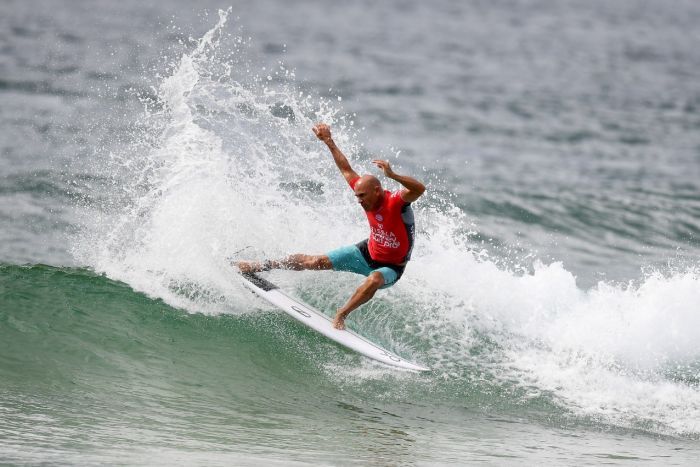 Photo: Eleven-time world title winner Kelly Slater owns a company that is experimenting with sustainable production but he, like all the best competition surfers, still rides boards made from petrochemical materials. (AAP: Dan Himbrechts)
Photo: Eleven-time world title winner Kelly Slater owns a company that is experimenting with sustainable production but he, like all the best competition surfers, still rides boards made from petrochemical materials. (AAP: Dan Himbrechts)He said design and production trends relied heavily on professional surfers.
The World Surf League had considered taking a lead from Formula One Racing by imposing production guidelines on elite competitors.
But the proposal was not treated seriously because of resistance from the top surfers.
“The surfers themselves would say, ‘look we want the best possible boards for riding on waves, that’s our priority’,” Carroll said.
“Until you can make the surfboards out of greener plant-based materials that match the performance of the board I’ve got under my feet right now, then I’m not a fan.”
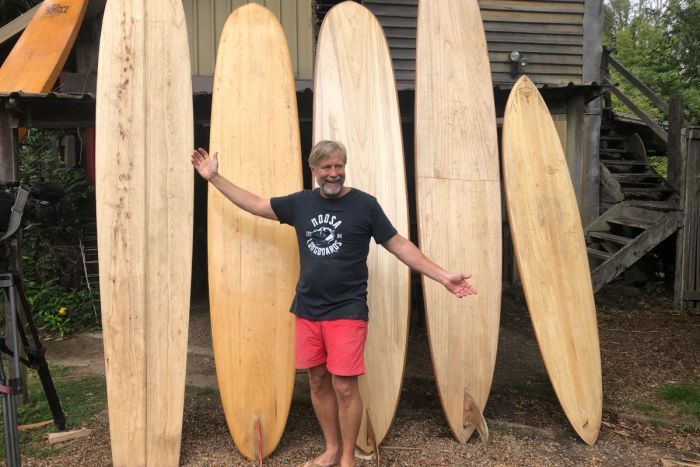 Photo: Tom Wegener aims to bring sustainable wooden surfboards into the mainstream. (ABC Landline: Sean Murphy)
Photo: Tom Wegener aims to bring sustainable wooden surfboards into the mainstream. (ABC Landline: Sean Murphy)Mr Wegener believes change may instead come from surfing’s grassroots.
“It’s going to be up to the do-it-yourself guys to push this idea and to get the kids onto it, and once the kids start doing it, making their own boards in their garages, which is simple to do with my process and with wood, you’ll see it just explode,” he said.
Watch this story on ABC TV’s Landline this Sunday at 12:30pm or on iview.
Topics: sport, surfing, environmentally-sustainable-business, sustainable-living, lifestyle-and-leisure, industry, environment, pollution, noosa-heads-4567, qld, australia, tweed-heads-2485, nsw

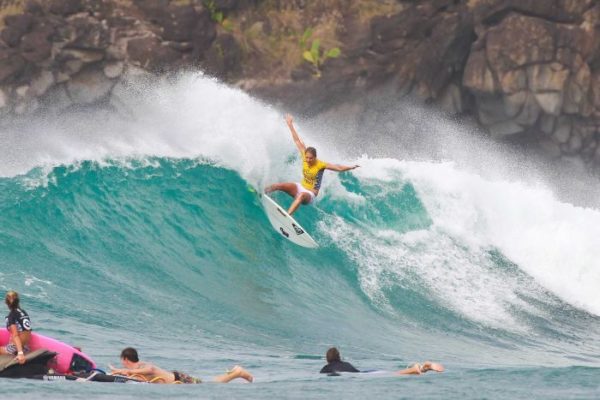




Recent Comments